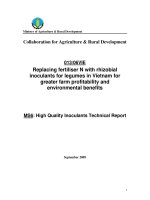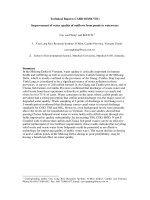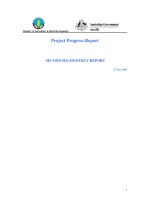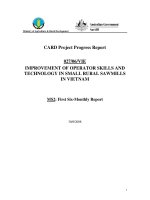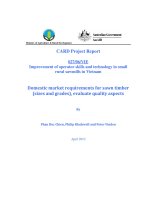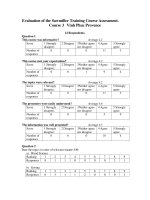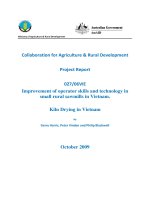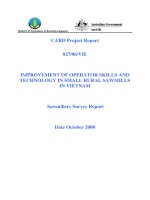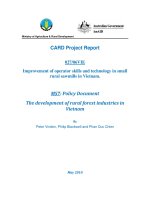Báo cáo khoa học nông nghiệp " Investigation of rice kernel cracking and its control in the field and during post-harvest processes in the Mekong Delta of Vietnam " docx
Bạn đang xem bản rút gọn của tài liệu. Xem và tải ngay bản đầy đủ của tài liệu tại đây (620.4 KB, 16 trang )
Ministry of Agriculture & Rural Development
Project Progress Report
FIRST SIX-MONTHLY REPORT
No of Milestone (MS) 2
Investigation of rice kernel cracking and its control in the field and during post-
harvest processes in the Mekong Delta of Vietnam
026/VIE05
September 2006
NONG LAM UNIVERSITY
1
Table of Contents
1. Institute Information___________________________________________________14
2. Project Abstract _______________________________________________________15
3. Executive Summary____________________________________________________15
4. Introduction & Background _____________________________________________15
5. Progress to Date_______________________________________________________20
5.1 Implementation Highlights_______________________________________________ 20
5.2 Smallholder Benefits____________________________________________________ 21
5.3 Capacity Building ______________________________________________________ 23
5.4 Publicity ______________________________________________________________ 23
5.5 Project Management____________________________________________________ 23
6. Report on Cross-Cutting Issues __________________________________________23
6.1 Environment __________________________________________________________ 23
6.2 Gender and Social Issues ________________________________________________ 24
7. Implementation & Sustainability Issues____________________________________24
7.1 Issues and Constraints __________________________________________________ 24
7.2 Options_________________________________________________________________
7.3 Sustainability____________________________________________________________
8. Next Critical Steps_____________________________________________________24
9. Conclusion___________________________________________________________24
10. Statuatory Declaration _________________________Error! Bookmark not defined.
2
1. Institute Information
Project Name
Investigation of rice kernel cracking
and its control in the field and during
post-harvest processes in the Mekong
Delta of Vietnam
Vietnamese Institution
Nong Lam University
Vietnamese Project Team Leader
Dr vinh Truong
Australian Organisation
The University of Queensland
Australian Personnel
Associate Professor Bhesh Bhandari
Professor Shu Fukai
Date commenced
April 2006
Completion date (original)
March 2009
Completion date (revised)
April 2009
Reporting period
6 months
Contact Officer(s)
In Australia: Team Leader
Name: Bhesh Bhandari
Telephone: +61733469192
Position: Associate Professor
Fax:+61733651177
Organisation: The University of
Queensland
Email:
In Australia: Administrative contact
Name: Mr Kerry Johnston
Telephone:
+61 7 3365 7493
Position: Research support officer
Fax:
+61 7 33658383
Organisation: The University of
Queensland
Email:
In Vietnam
Name: Vinh Truong
Telephone:
84-8-7242527
Position: Head, Department
of Chemical Engineering
Fax:
84-8-8960713
Organisation: Nong Lam
University
Email:
14
2. Project Abstract
Since the project commencement date of April 2006, three cooperatives were selected for
installation of driers and reapers in order to provide small holder farmers the technical
knowledge to practice optimum harvesting, and drying methods and conditions.
Systematic data collection was undertaken to quantify the amount of cracked rice in the
field due to early or delayed harvesting practices. Experiments were also conducted to
characterise a newly installed drier in one of the cooperatives. Extensive literature review
and preliminary experiments were conducted at the University of Queensland to apply
molecular relaxation concept into rice cracking. A systematic survey on milling losses
was undertaken to obtain actual data. A workshop was held in Can Tho for the extension
workers in order to provide them information about the project and to share each others
experience on the knowledge on the rice cracking. This project also assisted to continue a
collaborative working culture among various research teams across faculties in the Nong
Lam University and also between the University, Government organisations, farmers
cooperative and farmers. Training of one NLU staff member in Australia and visits of
project leader to rice research institutes in Thailand and Philippines will take place in
October 2006.
3. Executive Summary
There are four main project objectives that will be implemented phase wise during the
course of the project duration. These include (i) research in the field (ii) experimental
work on drying (iii) extension and training to farmers, service providers and extension
workers, and (iv) Training of Nong Lam University personnel engaged in the project.
During the past 5 months (April-Aug 2006) three farmers cooperatives were identified in
three different provinces (Can Tho, Kieng Giang and Long An) to implement various
activities. Each of these cooperatives was installed with one reaper/combined harvester or
a flat bed-dryer (8 ton capacity). Data collection on post-harvest losses (in more than two
provinces), harvesting time experiment (two cooperatives and one seed centre) and a
drying experiment were undertaken in various provinces and also at the Nong Lam
University. One MPhil student from Nong Lam University undertook preliminary work
on the application of glass relaxation concept to improve the mechanical property of rice.
One day seminar/workshop was organised
in Can Tho for extension workers and scientist
from post-harvest institutions to highlight the project objectives and also to obtain input
from the extension workers on grain losses in relation to harvesting, drying and milling
practices in Mekong Delta.
4. Introduction & Background
4.1 Project objectives
The specific objectives of this project are:
1. To identify and generate information for the appropriate harvesting method (manual
or mechanical) of rice to reduce grain cracking and losses.
15
2. To improve the performance of current driers and optimise the drying method to minimise the
broken portion on the basis of fundamental structural relaxation concept, particularly in a
high temperature compact-drying system.
3. To make the farmers, service providers, millers and extension workers aware of various
factors responsible for harvesting and milling losses and degradation of rice quality.
4. To increase the research and teaching capability of institution and staff members on rice
quality and related products.
4.2 Expected project outputs
The expected outputs during the last 5 months period were:
• Selection of cooperatives for undertaking experiments and as a centre for
demonstration to farmers
• Experiments to identify optimum harvesting methods to reduce grain loss
• Production of demonstration materials
• Experiments for optimum drying conditions identified for high temperature
compact dryers
• New process intervention introduced to validate molecular relaxation concept
• Reports/publications
• 39 extension workers are trained with new information
• Production of 6-monthly report
4.3 Approach and Methodology
The approach and methodology were adopted from the original project proposal. In this
project, the smallholder farmers are the major target for extension work through the pilot
farmers’ cooperatives particularly for Objectives 1 and 3. Three farmers cooperatives
were identified in three different provinces (Can Tho, Kieng Giang and Long An)
(Figures 1,2). As for Objective 2, the analysis of the problem will be analysed at micro or
molecular level using a glass-rubber transition and molecular relaxation concepts. This
new approach and understanding is expected to assist in developing high capacity dryers
which will use high drying temperature. As for Objective 4, strong research collaboration
will be fostered at NLU to capture the expertise from various departments and faculties;
research staff members will be trained in Australia and a visit will be organised for
project leader.
Figure 1: Location of three
cooperatives (in Can Tho,
Kien Giang and Long An
provinces) in Mekong Delta.
16
Figure 2: Visit of Tan-Phat A
farmers cooperative in Kieng Giang
province by Australian and
Vietnamese project personnel (8-
ton flat bed drier is installed in this
cooperative)
4.3.1 Implementation Methodologies
This project consisted of four main activities to achieve the goals as highlighted in the
objectives:
Objective 1 activities: Conducting experiments to relate harvesting time and methods on cracking
fraction of rice and losses for different varieties and seasons.
The objective of this experiment is to determine the effect of harvesting time on
kernel cracking and optimize harvesting period of some rice varieties in Summer-Spring
season in the MRD.
Harvesting time field experiments were conducted on two most cultivated varieties of
Tan Thoi 1 (Can Tho) and Tan Phat (Kien Giang) cooperatives, and in seed centre of An
Giang province. Optimum harvesting time for each variety was determined based on
analysis of experimental data. According to local survey results, the two most cultivated
rice varieties OM 2718 and OM 1490, An Giang 24 and Jasmine were chosen in Can
Tho, Kien Giang and An Giang provinces, respectively. Using a randomised block
design, the rice was harvested 6 days prior and 6 days post-maturity stages in 2 days
intervals. The number of rice kernels with cracks and chalkiness were measured for both
brown and milled rice. The full analyse of the results will be presented in the yearly
report.
Harvesting method (manual and harvester) comparison on the post-harvest losses was
also undertaken in Can Tho and Long An provinces. Cracking behaviour of the grain due
to threshing was also investigated in Can Tho and Kien Giang provinces. Data of the
actual harvesting losses due to current harvesting practice by farmers were collected in
Can Tho and Kien Giang provinces. Experimental design and data will be presented in
the next report.
Objective 2 activities: This comprised of the following activities:
Optimization of the drying method based on glass relaxation phenomenon.
17
An eight-ton capacity flat bed drier was installed in Tan Phat A cooperative located in
addition to the dryer installed in a cooperative, another one-ton lab scale flat bed dryer
wo mobile lab scale dryers were also built to dry the samples collected in the field
high temperature compact drier with a tempering system is being designed at Nong
igure 3: The 8-ton dryer installed at Tan-Phat cooperative, Kien Giang province
er operating at reversible air flow mode)
Tan-Hiep District of Kieng Giang Province. At first, we intended to contract the
construction of the dryer with additional features to a local dryer manufacturer, but no
contractor was willing to do it to meet our need. So, the research team decided to build
an air-reversible SRA-8 design from NLU with slight modifications. The installation of
the dryer was completed in mid-July 2006 (Figure 3), just in time for the wet-season
harvest, and for experimental purpose. This time the purpose of the experiment was to
evaluate the performance and throughput of the dryer at different drying regimes. The full
results and interpretations of this and forthcoming work will be submitted in the next
report. It is to note that this information will be provided to farmers and extension
workers during the training and seminar sessions.
In
is being constructed at NLU which will be used to undertake experiments under
controlled condition (Figure 4).
T
(Figure 5). These dryers were used in the field to dry the rice samples collected during
the harvesting time trials.
A
Lam University. It will be built in the next six months.
F
(second figure shows dry
-A
18
Figure 4: A one-ton drier being constructed at NLU for laboratory experiments
at controlled conditio s
ve
terature survey and preliminary experiments to characterise the cracking behaviour of
cal
on Test (Figure 6)
text
The re etnamese counterpart by providing recent literatures
lated to rice drying and cracking behaviour. At the moment her work is limited to a few
Figure 5: Mobile Lab scale cabinet dryer to dry the rice samples n
A Vietnamese student (Mrs Tuyen-Thuc Truong) working at UQ undertook extensi
li
Australian varieties of rice. The preliminary study included the followings:
• Analysis of physical properties and total amylose content of selected rice
varieties;
• Determination of glass-rubber transition temperature by Thermal Mechani
Compressi
• Effects of tempering on mechanical strength of rice (by texture analyser using
rig depicted in Figure 7).
searcher also assisted Vi
re
Australian rice varieties. She will be visiting Vietnam early next year to work on
Vietnamese rice varieties.
19
111 mm
0.5 mm
1 m
m
Objective 3 activities: This comprises of following sub-activities:
i. Demonstrations to the farmers and provincial pilot cooperatives on the benefit of
mechanical drying against sun drying and the economic value of the correct harvesting
time and method.
As indicated above each of the identified cooperatives was installed with one
reaper/combined harvester or a flat bed-dryer (8-ton capacity). The demonstration
materials are being prepared at present. The demonstration and training activity for the
farmers were not done during this period but will begin in the next 3 months.
ii. Study the performance of milling plants and solutions to improve the milling efficiency.
We have commenced to collect the data of milling losses in two provinces. The milling loss data
were collected directly from three milling plants in each province (Kien Giang and Tien Giang).
Since the work is being continued, the full report will be presented next year. The available data
will also be incorporated into the training manual.
Objective 4 activities: Training the staff members to improve the R &D and teaching capability in
rice science and technology.
There was no activity during this period, but one research worker from Nong Lam University will
be visiting University of Queensland from October. The project coordinator Dr Vinh Truong is
also visiting Thailand and Philippines in the first week of October.
5. Progress to Date
5.1 Implementation Highlights
The brief highlights of the project executed in the past 5 months are described below.
2.0 mm 2.5 mm 3.0 mm 3.5 mm
4.0 mm
90 mm
9 mm
99 mm
Figure 6: Texture analyser attached with a
UQ rig to measure the glass-rubber
transition of rice kernel (this device will be
duplicated in NLU next year)
Figure 7: UQ Rig to measure mechanical
strength of individual kernel of rice
(same device will be used at NLU)
20
5.1.1
Influence of harvesting time on rice cracking
Experiments conducted on two common rice varieties indicated that the rice cracking is
obviously influenced by the variety and time of harvesting. Harvesting the rice a few
days prior to maturity will not have much effect on rice cracking, but delayed harvesting
will result in significant rice cracking (up to 24% of total brown rice). Few representative
results obtained from two varieties are presented as below in Figure 8. A full analysis of
the data will be undertaken and will be presented in the next report. As planned, this
information will be included in the training document for farmers.
5.1.2 Drying of paddy using a reversible flat bed dryer
Some preliminary experiments on the 8-ton capacity dryer were conducted to characterise
this dryer. The work also quantified the energy consumption during the process per
kilogram of a paddy dried. Some highlights of this initial work are as follow:
- The effect of air reversal is very apparent in reducing the final moisture differential
which can influence head rice yield during milling
- Air reversal also decreased the drying time
- The drying temperature in the dryer was stable and can be kept within ± 2
o
C
- The husk and diesel consumptions per kg of rice dried were 33.45 kg and 1.77 litres,
respectively at a drying temperature of 43
o
C. The drying time for paddy was
approximately 12 hrs to bring the moisture down from 26 to 15% (wet basis).
However, the drying time decreased to 8 hrs by using two stage drying (50
o
C for 1 hr
followed by drying at 43
o
C).
These remarks are preliminary and need to be supplemented by data on milling analysis,
which is being undertaken and will be reported at a later stage. All these information will
be used in the extension work.
0.80
3.20
9.60
4.80
10.80
15.20
23.60
0.00
2.00
4.00
6.00
8.00
10.00
12.00
14.00
16.00
18.00
20.00
22.00
24.00
26.00
FTT1 FTT2 FTT3 FTT4 FTT5 FTT6 FTT7
Treatm ent
Cracking
percentage %
21
0.40 0.40
1.20
2.80
10.80
4.00
5.20
0.00
2.00
4.00
6.00
8.00
10.00
12.00
FTT1 FTT2 FTT3 FTT4 FTT5 FTT6 FTT7
Treatm ent
Cracking
percentage %
Figure 8: Cracking percentage of brown rice versus harvesting time (treatment
FTT1 earliest harvest time to FTT7 latest harvest time, FFT4 recommended harvest
time) for variety 1490 (top figure) and 2718 (bottom figure)
5.1.2
Glass transition phenomenon in relation to rice cracking
Some preliminary experiments were undertaken to determine an effective technique to
measure the glass transition temperature of rice and to investigate the effect of tempering
on the increase in the mechanical strength of rice. This was the preliminary work mainly
to establish the methodology and feasibility of the research. The glass transition was
successfully measured by TMCT (Thermal Mechanical Compression Test) device
developed at the UQ (Figure 9). The same technique will be used in NLU. The required
rig will be built at UQ. The results indicated that there is an increase in the mechanical
strength of the rice due to tempering at high temperature (Figure 10). The time required
for such changes will be longer at lower temperature. Further research is underway and
will be reported in consecutive reports.
5.2.4 Extension service
One day workshop was organised in the premises of Department of Agriculture and Rural
Development, Can Tho
on 23
rd
June 2006. There were more than 50 participants in this
workshop. The extension workers from various provincial councils in Mekong Delta
0
0.1
0.2
0.3
0.4
0.5
0.6
0.7
0.8
0.9
0 20 40 60 80 100 120 140 160 180
Temperature,
o
C
Displacement, mm
2.43%MC
19.50%MC
9.75%MC
7.81%MC
14.46%MC
Temperature, oC
Means of breaking force, N
806040
85
80
75
70
65
60
55
Time
120
240
0
40
Figure 9: Glass transition curve (point of
inflection of the curve indicates solid-rubber
transition or the glass transition)
Figure 10: Increased mechanical strength of
the rice due to tempering
22
shared the existing information and experiences on rice cracking. The document prepared
(in Vietnamese only) during the workshop will be presented in the next progress report.
5.2 Smallholder Benefits
The reaper and drier are installed in the cooperatives in which many of their members are
small holder farmers. We are not able to evaluate the benefits at this stage, but we will be
able to report the implementation and benefits in the forthcoming reports.
5.3 Capacity Building
Engagement of several staff members at NLU in the project has certainly helped to
contribute to the capacity building of those staff members. The project is implemented
through strong collaborative team comprised of various faculties and departments within
the NLU.
5
Nothing significant has been done with this respect. However, a team of NLU personnel
including vice rector visited various provincial extension offices to provide the
information about the project and to gain their direct s
phase (Figure 11).
A poster/pamphlet is prepared to highlight the project objectives a
attached with this document). Number of copies
extension workers, cooperative members and communes.
ent) who are
elping the project implementation. Support for the monitoring the project, project
as been received from Australian collaborators.
6.1 Environment
.4 Publicity
upport during the implementation
nd activities (a copy
of this pamphlet has been distributed to
Figure 11: Visit of Nong Lam
University project team to Provincial
Departments of Agriculture and
Rural Development to highlight the
project objectives
5.5 Project Management
The project has been managed by the team leader Dr Vinh Truong at NLU. Dr Truong
has received sufficient support form all higher authorities and sub-ordinate staff members
at NLU. There are 4 junior staff member (including one research stud
h
planning and reporting h
6. Report on Cross-Cutting Issues
23
Nothing significant report to date.
. Implementation & Sustainability Issues
ngoing experience has given
nough confidence to the project execution team for the future implementation strategy.
At this stage there are no pertaining issues, except requirement of some advance financial
payments.
It should be pointed out here that the amount allocated following each milestone deadline
does not match with the investment to be ma and other
equipment. The delay start of the project a he
actual progress has been pushed forward by date of
the project was May 2006). To build the dry such
as texture analyser, and to undertake various other training activities the amount is
required in advance. A MPhil student who is working in Australia using Australian
varieties of rice will do field trial in Vietnam using Vietnamese varieties. She will need
e texture analyser in Vietnam. Since she plans to come to Vietnam in January 2007
uring Jan-Feb harvest time) and also the purchase of this instrument is scheduled for
t that we receive a sum of money in advance in order to be
individuals from the University,
ents and farmer’s cooperatives. The project is quite sustainable in the
t. In our experience, cooperative model to implement the project is
tion and enthusiasm of the cooperatives have been
s
lanned in the log-frame in the next 6 months. There
training to farmers,
ta. We will focus on
onths.
6.2 Gender and Social Issues
Nothing significant to report to date.
7
7.1 Issues and Constraints
The project has been implementation as planned. The o
e
de for the purchase of the driers
lso contributed to this difficulty since t
two months (actual commencement
er/reapers and purchase the equipment
th
(d
the same year, it is importan
able to order the equipment by late November.
7.2 Options
The only option to ensure that each activity can be done according to the plan is to make
two payments of $29000 in the next milestone.
7.3 Sustainability
The project has received enough support from various
provincial governm
current environmen
expected to be a success. The recep
very encouraging.
8. Next Critical Step
The project will be implemented as p
will be much more work in the next 6 months which will involve
service providers and extension workers, and collection of more da
training part of the program in the next 3 m
24
9. Conclusion
The project has been successfully commenced. The project outcome has been as expected
and has met the milestone. Due to the delay start of the project certain outcomes are still
due. Within this short period of time we have been able to collect a number of important
information on rice cracking. This information will be passed onto all stakeholders in the
form of training manual and other documents. This project has also contributed to build a
strong collaborative team within NLU. In the next stage, it is expected that the project
implementation will be as smooth as has been in the past 5 months.
25
26
27

